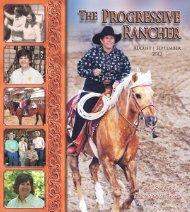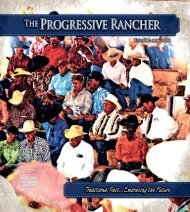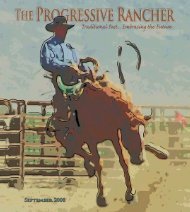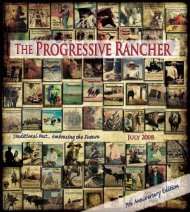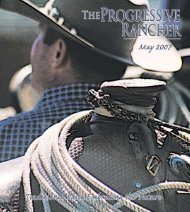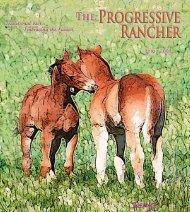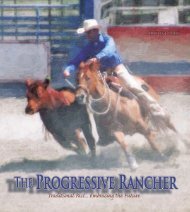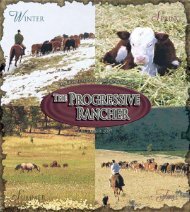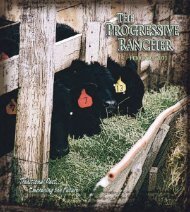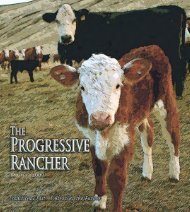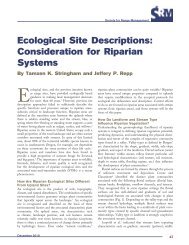NCA 2009 President's Award Recipient - The Progressive Rancher ...
NCA 2009 President's Award Recipient - The Progressive Rancher ...
NCA 2009 President's Award Recipient - The Progressive Rancher ...
You also want an ePaper? Increase the reach of your titles
YUMPU automatically turns print PDFs into web optimized ePapers that Google loves.
Invited Property Rights Editorial<br />
Note: <strong>The</strong> opinions expressed herein are strictly those of the author. <strong>The</strong> <strong>Progressive</strong> <strong>Rancher</strong> does not endorse submissions, but allows all to voice their views.<br />
<strong>The</strong> Future of Nevada Ranching:<br />
Do <strong>Rancher</strong>’s Property Rights Matter?<br />
Over 20 years ago, thirty Clark County ranchers<br />
were driven out of business when the Bureau<br />
of Land Management (BLM) began using the terms and<br />
conditions of grazing permits to protect the desert tortoise<br />
instead of rancher’s who had preexisting rights to run livestock.<br />
While the tortoise was never actually listed as “endangered”<br />
under the Endangered Species Act, cows were<br />
deemed to be a threat because they might step on tortoise<br />
eggs. <strong>The</strong> fact that cows, sheep and tortoises had cohabitated<br />
for more than a century was ignored.<br />
<strong>The</strong>n in 1998, the Southern Nevada Public Lands Management<br />
Act was passed by Congress. <strong>The</strong> Act legalized<br />
public land sales in Clark County, lands which included<br />
some of those same rancher’s adjudicated grazing allotments.<br />
<strong>The</strong> Clark County ranchers were never compensated<br />
for their vested water rights, forage rights, range improvements,<br />
easements and rights of ways. <strong>The</strong>y were simply<br />
eradicated by the heavy hand of BLM regulations. Lands<br />
that were formerly deemed to be tortoise habitat were sold<br />
to developers armed with excavators and paving equipment.<br />
Meanwhile, environmentalists and the BLM are mostly<br />
mute on the subject of the desert tortoise.<br />
So far 39,378 acres have been sold in Clark County for<br />
over $3 billion dollars for an average of $77,253 per acre.<br />
According to the BLM 2010 Report to Congress (http://<br />
www.blm.gov/pgdata/etc/medialib/blm/nv/field_offices/<br />
las_vegas_field_office/snplma/pdf/reports.Par.90311.File.<br />
dat/SNPLMA_FY2010_Annual_Report.pdf), ten percent<br />
of those moneys were funneled to the Southern Nevada Water<br />
Authority and five percent to education. <strong>The</strong> remaining<br />
funds went to the Department of Interior for land acquisition<br />
and conservation. To date, a total of 69,120 acres of<br />
mostly ranch lands have been acquired—in a state which<br />
is already 87 percent government controlled. <strong>The</strong> BLM and<br />
U.S. Forest Service pursued policies burdening grazing permits<br />
with so many conditions, they forced many ranchers<br />
to become “willing sellers” of their devalued ranches and<br />
prime targets for land acquisition.<br />
<strong>The</strong> sage grouse is the new desert tortoise or spotted<br />
owl to be deployed against the Nevada rancher, the mining<br />
industry, hunter and recreationalist. <strong>The</strong> objective is the<br />
same—force ranchers to walk away from their vested water<br />
rights, forage rights, range improvements and easements<br />
without compensation, or at the very least convert them into<br />
“willing sellers” at a discount.<br />
Since 1982 Nevada has lost over one-third of its cattle<br />
production, down from 700,000 to 450,000. Sheep production,<br />
which peaked at 3 million in the 1920’s, is now down<br />
to a mere 70,000. <strong>The</strong>se losses are largely due to the cuts the<br />
BLM and USFS have imposed on ranchers through grazing<br />
permits. Computing both direct and indirect economic<br />
impacts, Nevada has lost well over one billion dollars in<br />
economic activity as a result. 1<br />
Rather than following the land management laws of<br />
by: Ramona Hage Morrison<br />
Congress which specifically protect rancher’s preexisting<br />
property interests in vested water rights, forage rights, easements,<br />
rights of ways and range improvements, the agencies<br />
promote policies that eliminate livestock. By extension,<br />
their policies encourage massive rangeland fires and the infestation<br />
of weeds and cheat grass—something previously<br />
not witnessed in Nevada. <strong>The</strong> agencies assigned to protect<br />
and manage the western rangelands and forests instead<br />
have created what can only be described as an ecological<br />
disaster. Conversely, rangeland grazing by livestock has<br />
always corresponded to greater wildlife populations, better<br />
access to areas for recreation, and greater water yields from<br />
watersheds that supply irrigation and recharge aquifers.<br />
<strong>The</strong> question remains—what can individual ranchers<br />
do to protect their property rights from the sage grouse?<br />
<strong>The</strong> short answer is we need to force the federal land management<br />
agencies to follow their own laws. Additionally,<br />
we need to document preexisting rights and learn to defend<br />
those property rights. Finally, seek the protection of the<br />
courts, armed with an exhaustive chains of title, attorneys<br />
experienced in this area of law, and carefully framing the<br />
issues in a manner which recognizes preexisting rights.<br />
Every land law passed by Congress has provisions protecting<br />
preexisting rights. For example, Congress was very<br />
clear in the 1976 Federal Land Policy and Management Act<br />
when it stated: “Nothing in this Act, or in any amendment<br />
made by this Act, shall be construed as terminating any<br />
valid lease, permit, patent, right-of-way, or other land use<br />
right or authorization existing on the date of approval of<br />
this Act...” (43 U.S.C. 1701 notes).<br />
Nevada’s ranches were settled well before the creation<br />
of the Forest Reserves and the passage of the Taylor Grazing<br />
Act. Nevada’s prior appropriation water law is based<br />
upon recognition of preexisting beneficial use of water.<br />
Vested stock water rights and range (i.e. forage rights) were<br />
put to beneficial use well before the statutory water law<br />
in Nevada, and an equitable estate was created under the<br />
local laws, customs and court decisions of the time. Most<br />
of Nevada’s range and stock waters were bought, sold, or<br />
transferred by inheritance for 40 years before the creation<br />
of the Forest Service or BLM. Property taxes were assessed<br />
on the use of the range by taxing the livestock. Inheritance<br />
taxes were also assessed on the value of the range, and still<br />
are by the IRS. (See Griffith v. Godey, 113 U.S. 89 (1885)).<br />
<strong>The</strong>se rights can and should be documented with an exhaustive<br />
chain of title. (See previous article in <strong>The</strong> <strong>Progressive</strong><br />
<strong>Rancher</strong>, February 2013, page 7)<br />
<strong>The</strong> road ahead for the ranching industry is riddled<br />
with attacks on our property rights, and on our very liberty.<br />
<strong>The</strong> past is riddled with bad case law as it relates to the<br />
rangeland ranching industry. Many of the worst court decisions<br />
were cases where ranchers argued they had rights by<br />
virtue of a grazing permit, rather than that they owned preexisting<br />
property rights acquired by their predecessors under<br />
the local laws, customs and court decisions of the time.<br />
We are a nation of laws, but to some extent our industry<br />
has been ineffective in forcing the federal agencies to follow<br />
their own laws. When it comes to the federal grazing<br />
programs, often government employees ignore those very<br />
laws in the enforcement of their own rules and regulations.<br />
When bureaucrats act outside their lawful delegated authority,<br />
they are no longer protected by immunity from personal<br />
liability afforded a government employee.<br />
In the 1991 Fifth Amendment takings case of Hage v.<br />
U.S. filed in the U.S. Court of Federal Claims, and in U.S.<br />
v. Hage, the 2007 forage right case filed in Nevada Federal<br />
District Court, as well as the Southern Monitor Valley Water<br />
Adjudication, the primary evidence before the court was<br />
an exhaustive chain of title documenting the preexisting<br />
use of and rights to the range and vested waters. My family,<br />
thankfully, has prevailed in all of these cases against<br />
great odds and adversity. Even in the July 26, 2012 Federal<br />
Circuit Court of Appeals decision, which reversed, upheld<br />
and remanded narrow portions of Judge Loren Smith’s eight<br />
published rulings from the U.S. Court of Federal Claims,<br />
all of Judge Smith’s property findings were left intact by<br />
the court. <strong>The</strong> Federal Circuit also reversed its previous<br />
disastrous ruling from Colvin v. U.S., when it ruled in the<br />
Hage case that we did, in fact, have a right of access to our<br />
waters. (<strong>The</strong> Federal Circuit Court of Appeals decision in<br />
Hage v. U.S. is currently on appeal to the United States<br />
Supreme Court.)<br />
<strong>The</strong> future of the ranching industry will depend, in my<br />
opinion, in great part on how effective we are in protecting<br />
our property rights. We’ve come a long way. Prior to my<br />
father, Wayne Hage, writing “Storm Over Rangelands”,<br />
many ranchers had no idea they owned anything, including<br />
their water rights, on the public domain. Twenty year ago,<br />
most judges and lawyers would argue the same position.<br />
Today, however, copies of “Storm Over Rangelands”<br />
are housed in the U.S. Supreme Court law library as one of<br />
the few authorities on western federal land law not funded<br />
or published by a government entity. <strong>The</strong> numerous published<br />
decisions in the Hage cases have clarified the issue of<br />
whether or not ranchers own property interests in the nature<br />
of an equitable estate on lands managed by the BLM and<br />
Forest Service. And we have learned a little along the way<br />
about how to plead cases for the greatest chance of success<br />
in the court system. <strong>The</strong>re have also been mistakes made<br />
from which we have learned as well. But either way, the<br />
objective was that we could blaze a trail for defending the<br />
western rancher’s property rights which others can follow.<br />
I am optimistic that is being accomplished.<br />
I am also optimistic that Nevada’s ranchers can defend<br />
their property rights against a plethora of environmental<br />
schemes, including the sage grouse. <strong>The</strong> rancher’s preexisting<br />
property rights are the only real line of defense to stop<br />
the continued abuse of powers.<br />
1<br />
<strong>The</strong> Economic Impact of Nevada Livestock Industry, Anthony L. Lesperance, Ph.D. (2002)<br />
www.progressiverancher.com <strong>The</strong> <strong>Progressive</strong> <strong>Rancher</strong><br />
April 2013 15



